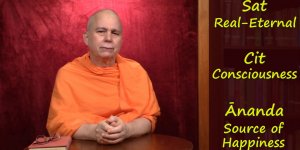| / Documentaries / Philosophy, Religion |
Introduction to Advaita Vedanta
Part 3/6: Unchanging Consciousness
A video presentation by Swami Tadatmananda Saraswati, Arsha Bodha Center, United States
(Tapescript) Welcome! In the prior presentation we explored the nature of the true self, atma, which is the essence of your being.
The scriptures describe atma as sat-cit-ananda, the unborn, eternal being, sat, which is pure consciousness, cit, and the source of happiness, ananda.
This inner reality is usually obscured or covered by a veil of ignorance, and as a result, we end up identifying ourselves not as sat cit ananda, but instead, as being male or female, young or old, healthy or ill and so on. Yet, these traits really belong to our bodies, not to the conscious being that we truly are.
With the help of Vedanta’s teachings, we can discover the fact that atma is completely independent of the physical body. This discovery results in a healthy detachment towards the body and eliminates any suffering it might cause.
In this presentation, we shift our focus from the body to the mind.
Just as failing to discern atma’s independence from the body causes suffering, the failure to discern atma’s independence from your mind only causes additional suffering, but it’s a much more subtle and insidious kind of confusion, as we will see.
To begin our inquiry, we can once again employ the important Vedantic method of drik drisha viveka, the technique of differentiating or distinguishing the seer from the seen, the observer from the observed, the knower from the known.
As we saw before, anything known to you is an object, and is therefore different or separate from YOU, the conscious, knowing observer. Everything in the world, including your own body, can be known to you as an object, and is therefore different from you.
Now, what about objects, not in the world, but in your mind, mental objects, like thoughts? The activities of your mind are also known to you, just like objects in the world are known to you.
Such mental objects or activities are known as vrittis in Sanskrit.
We can divide these vrittis into three categories: perceptions, cognitions, and emotions.
Some vrittis are produced by your sense organs. Whatever you see, hear, taste, smell, or touch is conveyed to your mind where they arise as vrittis and become known to you. These vrittis are known as perceptions.
In addition to perceptions, other vrittis that arise in your mind are produced by your intellect, your buddhi. These vrittis can simply be referred to as thoughts, but psychology books call them cognitions.
Finally, the third kind of vritti includes all your emotions. Happiness and sadness, anger, disappointment, joy and love - all these emotions arise as vrittis in your mind.
Every activity of your mind falls into one of these three categories: perceptions, cognitions, or emotions.
All these vrittis arise in your mind and become known to you, the conscious observer. As the knower of these vrittis, you are necessarily separate and different from them. You are the observer, and they are the observed.
But, even though these vrittis are separate from you, they certainly seem to affect you, whether they are perceptions, cognitions, or emotions. When you smell something really foul, the terrible stench seems to affect you. When a dear friend has inexplicably stopped returning your emails and phone calls, great uncertainty seems to affect you. When happiness or sadness arises in your mind, those emotions definitely seem to affect you. Everything that happens in your mind seems to affect you, the conscious being, the observer of those vrittis, atma.
However, the ancient rishis discovered that consciousness is utterly unaffected by all the perceptions, cognitions, and emotions that arise in your mind. So, whatever happens in your mind doesn’t truly affect you, the conscious being.
Let’s find out how this can be so. The rishis explained this with a metaphor: the sun reveals countless objects in the world by shining upon them, by illumining them.
But, the sun doesn’t get affected in any way whatsoever by what it shines upon.
If the sun shines on a sacred scripture, it doesn’t become holy. If the sun shines on a filthy gutter, it doesn’t become impure.
Likewise, the consciousness that illumines the activities of your mind is not truly affected by the vrittis that it illumines.
That means, when consciousness reveals the presence of happiness in your mind, consciousness doesn’t become happy. And when it reveals the presence of sadness in your mind, consciousness doesn’t become sad.
On the other hand, this assertion seems to absolutely contradict our usual experience. When happiness or sadness arises in our minds, we definitely feel like those emotions affect the consciousness that reveals them.
However, if we examine this more carefully, it turns out to be another situation in which we misinterpret our experiences. We’ve already discussed how easy it is to misinterpret our experiences, like when we watch the sunset. The sun doesn’t go down; it actually remains stationary in the sky while we stand on a rotating planet and slowly tilt over backwards. Yet, we wrongly say that the sun is going down.
Just as we misinterpret our experience of the sunset, we also misinterpret our experiences of happiness, sadness, and everything else that arises in our minds.
How does this confusion take place?
Your vrittis are in a constant state of flux. In your mind, perceptions, cognitions, and emotions continually change, from moment to moment.
If you, the conscious observer, are to accurately observe the constantly changing vrittis, you must necessarily be an unchanging observer.
Why? If the observer changes along with the vrittis, how could their changes be recognized?
For example, suppose you’re driving on the freeway at 60 mph, and in the lane next to you, there’s another car traveling at exactly the same speed. When you glance at the other driver, you can see that he’s drinking coffee while driving. He’s actually drinking coffee at 60 mph, but is that what you experience? No. You see him sitting motionless in the driver’s seat, sipping his coffee.
If you want to see him drink coffee at 60 mph, you have to watch from the roadside, standing still. Only as an unmoving observer can you accurately perceive him drinking coffee at 60 mph.
This example shows that only as an unchanging observer of your vrittis can you accurately experience their continually changing nature.
To understand this more clearly, try to visualize this: suppose a grey cloud of sadness were to gradually descend upon your mind.
If you, the observer of your mind, were to simultaneously become grey, as the grey cloud pervaded your mind bit by bit, could you really sense or detect the growing presence of the grey cloud of sadness?
In order to observe sadness descending upon your mind, you must necessarily be an unchanging observer.
And, an unchanging observer is completely unaffected by whatever is being observed, like the sun is completely unaffected by all that it illumines.
This is true not just for sadness, but for all the activities of your mind, for every perception, cognition, and emotion. When you see the blue sky, you, the observer, don’t become blue. When you smell a foul stench, you, the observer, don’t stink.
These perceptions don’t affect you, because you are the conscious observer, separate and distinct from the vrittis that arise in your mind.
This applies to your cognitions, as well. Whether you are engrossed in problem solving at work, or you are balancing your checkbook, or you are planning a vacation, the vrittis that arise in your mind due to these cognitive activities are all observed by you.
As the unchanging conscious observer, separate and distinct from all those cognitions, you are completely unaffected by them.
You are the unchanging observer, not only of your perceptions and cognitions, but of all your emotions, as well.
When you feel angry, hurt, joyful or worried, these feelings arise as vrittis in your mind. Once again, as the unchanging conscious observer, separate and distinct from all those emotions, you are completely unaffected by them.
Yet, if anger, hurt or joy arises in your mind, you’d probably say, “I am angry,” or “I am hurt,” and so on. You would never say, “I’m not angry; but some anger has arisen in my mind.”
Hmm... But, as odd as that may sound, that’s exactly what happens.
When anger arises in your mind, you, the unchanging conscious observer, do NOT become angry. You say, “I am angry,” because anger SEEMS to affect you. It seems to somehow rub off on consciousness, as if consciousness were stained or tainted by these emotions. But if consciousness illumines vrittis, like the sun illumines objects in the world, then how can it actually be affected?
Vedanta uses a wonderful example to show how activities of your mind, like your emotions in particular, seem to taint or affect you, the unchanging observer.
This crystal, as you can see, is perfectly clear. Yet, when I hold it in front of my robes, it appears to become orange. The orangeness that belongs to my robes seems to have affected the crystal, changing its color.
Of course, this crystal remains clear, but it certainly appears orange.
In the same way, emotions that belong to your mind seem to rub off on you, so to speak, they seem to taint or affect you somehow, even though, as an unchanging conscious observer, you are actually unaffected by those emotions in any way.
Due to the nearness or proximity of this crystal to the cloth, the orangeness of the cloth appears in this crystal. If I hold the crystal at a distance, it won’t appear orange.
Then, let me ask you, what is the distance between your vrittis and you, the conscious observer? What is the distance between consciousness and your perceptions, cognitions and emotions?
There’s no distance at all. Every vritti is bathed in consciousness, like fields and forests bathed in sunlight.
Due to the close proximity between your vrittis and consciousness, the qualities of the vrittis, like sadness and hurt, seem to taint or rub off on unchanging consciousness, like the orangeness of the cloth seems to taint this clear crystal.
Now, let’s consider the next point. This crystal remains perfectly clear, even now, while it appears orange. It’s orangeness is only an appearance, not a reality.
The orangeness of the cloth is real, but the orangeness of this crystal is a mere appearance. The crystal’s orangeness is false. It’s false like a snake projected on a rope in the dark alley. It’s false like the sun’s apparent travel towards the horizon each evening.
Even when the sun appears to go down, we know that it’s actually stationary. Even when the crystal appears orange, we know that it remains perfectly clear.
And even when sadness and hurt appear to rub off on consciousness, we know that unchanging consciousness remains utterly unaffected.
Suppose you want a clear crystal, right now. Well, there’s nothing that needs to be done. It’s always clear, in spite of its appearance.
In the same way, if you want to be completely unaffected by sadness, anger and hurt, there’s absolutely nothing that needs to be done. The consciousness that’s your essential nature remains unchanged and unaffected by your emotions.
This is one of Vedanta’s most important teachings. This truth must be personally discovered with perfect clarity and unfettered by doubts. The scriptures say, hastamalakavat jnayate, “it must be known as clearly as a fruit in the palm of your hand.”
The problem is, for most people, this great truth remains hidden, unheard and unknown. For those fortunate enough to hear these teachings, even when this truth is known, it might not be known with perfect clarity and unfettered by doubts.
So, for the sake of making this knowledge perfectly clear and doubt-free, Vedanta employs a variety of techniques, and one of those techniques is meditation.
There’s a particular meditation technique that can help you gain clear, doubt-free knowledge of the truth that you, as the unchanging conscious observer, are utterly unaffected by the activities of your mind.
To introduce this meditation technique, let’s examine our orange crystal again. Suppose you’ve only seen this crystal in the proximity of the cloth; so, every time you’ve seen the crystal, it’s appeared orange to you.
Now, even though I tell you that this crystal is really clear, and even though you have no reason to doubt my words, so far, you’ve only experienced an orange crystal. And as a result of this, you might have some doubts as to whether or not this crystal is truly clear.
In the same way, all your experiences, throughout your entire life, have taken place in the presence of vrittis, vrittis that seem to affect or color consciousness due to their close proximity.
Even though Vedanta tells you that consciousness isn’t affected by those vrittis, and even though you have no reason to doubt the teachings of Vedanta, you might still have some doubts as to whether or not consciousness is truly unaffected by vrittis. But, those doubts could be removed by the experience of being a conscious being in the absence of those vrittis which always seem to taint consciousness.
Back to the crystal. Suppose I remove this crystal from the cloth, just for a few moments. Watch carefully. Now, in those few moments, you could see, without doubt, that this crystal is perfectly clear. Even though the crystal appears orange again, you don’t have any doubts about it truly being clear. Your brief experience of the clear crystal soundly confirmed what I’ve been telling you all along; that this crystal remains clear in spite of the continued appearance of orangeness.
Now, to confirm the fact that this crystal really is clear, how long should be your experience of the clear crystal? Should I hold it away from the cloth for several minutes or several hours? That’s certainly not necessary. An experience of just a few moments is enough to experientially confirm the clearness of the crystal.
Based on this example, suppose you were to practice a simple meditation technique that could make your mind absolutely quiet, just for a few moments. You don’t need to be an advanced yogi. You don’t need to practice samadhi for hours at a time. You only need to silence your mind for just a few moments. That shouldn’t be too hard.
A few moments of silence can easily be produced in the interval or gap between mental repetitions of a mantra. For example, if your mantra is om namah shivaya, after reciting shivaya and before reciting the next om, there’s a tiny gap.
If you recite the mantra for a long time, it’ll eventually become firmly established in your mind. Then, when it’s firmly established, you can gradually increase the gap between mantras like this: om namah shivaya...
When you’re meditating, during the gap between mantras, there are no thoughts, no perceptions, and no emotions.
What remains?
You remain. You remain present as consciousness, unchanging consciousness.
And in that gap between mantras, you can personally discover that consciousness is utterly untainted by any mental activity whatsoever.
Let me explain.
When I remove this crystal from the cloth, not a trace of orangeness remains, because the crystal was never affected in any way by the orangeness. In the same way, when all vrittis cease for a few moments, you can discover that consciousness is utterly free from any trace or residue left over from those vrittis, because consciousness was never affected by them in the first place.
Using meditation in this way, you have an opportunity to experientially confirm what Vedanta has been telling you; that your true nature as an eternal, conscious being is utterly unaffected by anything and everything that happens in your mind.
When this knowledge is perfectly clear and doubt-free, you will no longer be subject to suffering caused by your vrittis, whether they are perceptions, cognitions, or emotions.
If you smell a foul stench, you’ll know that consciousness remains utterly unaffected. If your mind is filled with uncertainty and confusion, you’ll know that consciousness remains utterly unaffected. And when a cloud of sadness descends upon your mind, you’ll know that consciousness always remains unaffected.
Consciousness forever remains full and perfect, even in the presence of vrittis. Just like this crystal remains clear even in the presence of orangeness.
That consciousness, unchanging, full and perfect, that consciousness is your essential nature, sat cit ananda, atma.
YOU MAY ALSO LIKE





